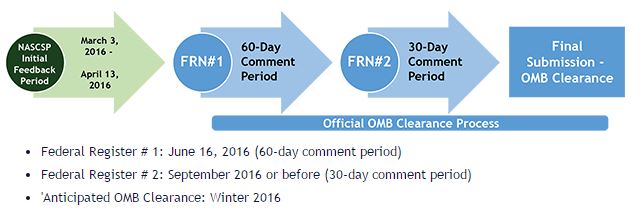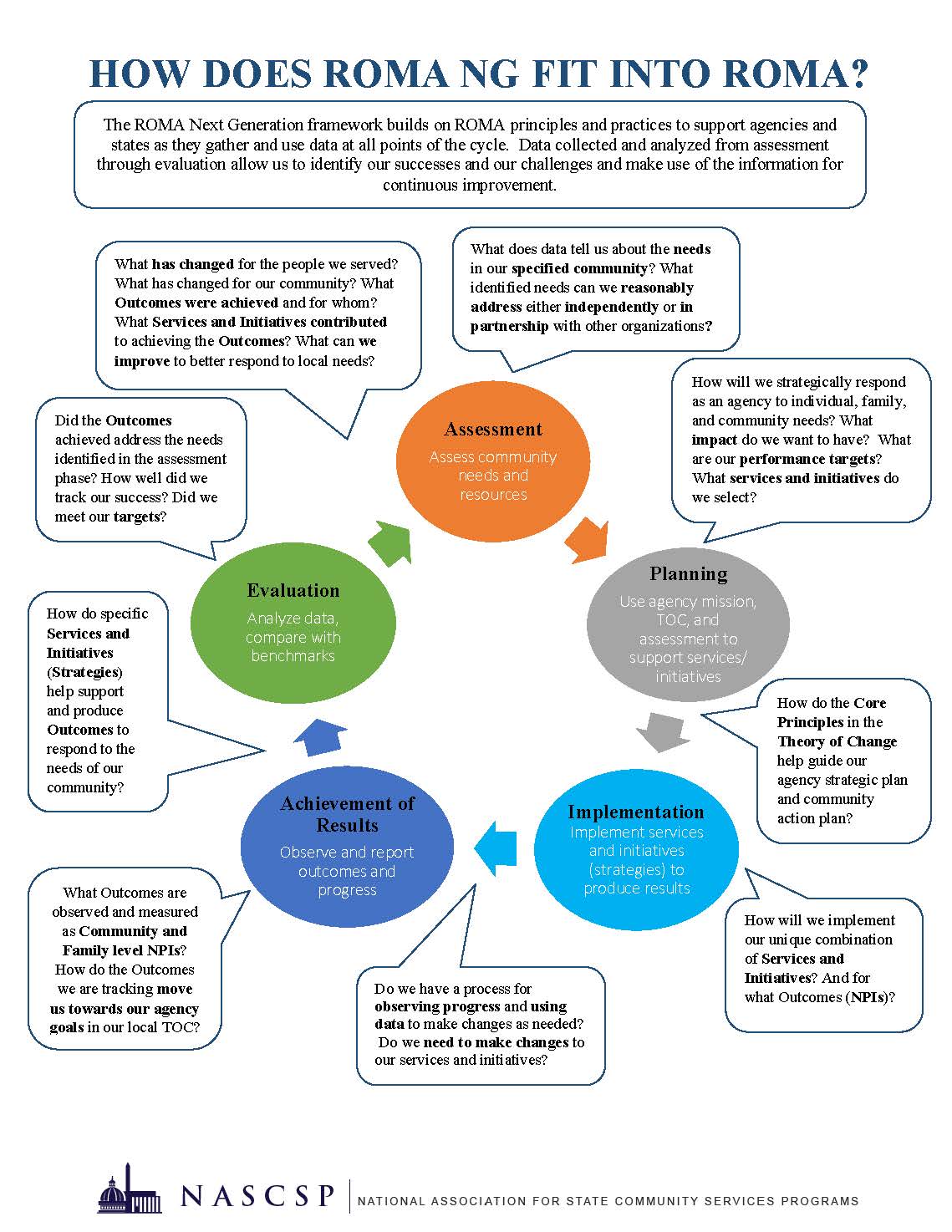The first Federal Register Notice (FRN#1) comment period is currently under way and OCS and NASCSP are eager for your feedback. For more information about the OMB Clearance process and the FRN#1, click here. To view the CSBG Annual Report, please go to the Notice for Public Comment, OCS’ Dear Colleague Letter, or download it here. This comment period will last 60 days, June 16, 2016 – August 15, 2016. Please submit your comments to infocollection@acf.hhs.gov, as directed in the Federal Register notice. For more detail on submission, and what the OMB Clearance process entails, see here. The graphic below shows the steps in the process.

In addition to providing the revised CSBG Annual Report packet currently under comment (which contains the modified and revised ROMA Next Generation components many of you reviewed in the Initial Feedback Period), NASCSP has developed tools and resources to support your review of the material. Please note that the documents provided as supplemental tools were not submitted as part of the clearance packet! These supplemental tools were built to assist in the comment making process and are intended to help your review and interpret the changes and rationale behind various elements of the document. All these tools were created to answer some of the top questions that we’ve heard from you!
1. Some of these might be big changes! What is the timeframe for the CSBG Annual Report implementation?
|
Reporting Timelines for States and Agencies |
||
| Please click here to see your State’s Reporting Period for FY 18 | Reporting Timeline for States: |
Reporting Timeline for Agencies: |
| Module 1 – State Administration | FY16 Annual Report Due March 2017 |
n/a |
| Module 2 – Agency Expenditures, Capacity, and Resources | FY18 Annual Report Due March 31, 2019 |
Data collection begins in FY18 |
| Module 3 – Community Level | FY18 Annual Report Due March 31, 2019 |
Data collection begins in FY18 |
| Module 4 – Individual and Family Level | FY18 Annual Report Due March 31, 2019 |
Data collection begins in FY18 |
2. Are example excel spreadsheets for each individual module within the Annual Report also available for review?
The excel spreadsheets for modules 2-4 are available below. We have built these to better showcase the interactive nature of many of the forms. Please note, NASCSP continues to review the formulas in the NPI data entry forms and encourages you to inform us if any additional revisions must be made.
CSBG Annual Report Modules (updated 6/27/2016)
- Module 2: Agency Expenditures, Capacity, and Resources(.XLSM)
- Module 3: Community Level(.XLSM) (updated 6/27/2016)
- Module 4: Individual and Family Level(.XLS) (updated 6/27/2016)
3. What would these Modules and the agency-level data look like aggregated to the State and National Level?
We’ve created sample State and National Reports for Module 3 (updated 6/27/2016) and Module 4 (updated 6/27/2016) to show how the data elements would aggregate to the State and National level, based on the data that agencies submit in the Modules. It’s important to see that some of the data elements aggregate in a different format, so we encourage you to review these samples to get a sense of how your data would roll up to each level.
4. What is the underlying theory behind ROMA Next Generation and the individual, family, and community outcomes we are working towards?
The Theory of Change (TOC) is intended to provide a graphic overview of the core principles, performance management framework, and services and strategies implemented and led by the network to achieve the goals of Community Action across the nation. Please note we are currently reviewing all your feedback from the initial feedback period and will be updating this graphic to include your suggestions. We hope our Discussion Guide will help you walk through the theory and assumptions encapsulated in the TOC graphic.
5. I don’t know what goes into building a Collective Impact Initiative and I don’t understand how it is different than a partnership. How do I know if I’m involved in one, and how can I track progress as part of this collaborative, complex work?
Our Collective Impact Tool lays out the early, middle, and late stages of a Collective Impact Initiative and what types of work goes into building one. It’s also designed to help you set milestones and goals and ensure you and your partners are moving in the same direction!
6. How does ROMA fit into ROMA Next Gen and all these pieces of the performance management framework? Can you help me visualize the ROMA framework and understand where all the pieces live that I’m familiar with?
 As we worked through your feedback, we noted areas of possible misinterpretation, so we created this myth-buster blog to help demystify ROMA Next Generation. Also, make sure to check out this ROMA NG/ROMA Graphic that shows how ROMA and ROMA Next Generation build on each other.
As we worked through your feedback, we noted areas of possible misinterpretation, so we created this myth-buster blog to help demystify ROMA Next Generation. Also, make sure to check out this ROMA NG/ROMA Graphic that shows how ROMA and ROMA Next Generation build on each other.
Through ROMA Next Generation, we’re introducing new tools and a revised framework to support the analysis of services and strategies provided and the impact of these services and strategies on individual and community change. These efforts promote the full implementation of the ROMA Cycle, continue the movement of the CSBG Network towards a robust and transparent process for collecting and analyzing data, and ensure that the CSBG Network is implementing services and strategies for maximum impact at all levels!
7. How does the CSBG Annual Report match what we’ve been reporting in the CSBG IS? How does it align with what was presented during the Initial Feedback Period? Can you break down the changes step by-step for me?
The CSBG IS/ROMA NG/Annual Report Crosswalk breaks down the connections between the CSBG IS, the components presented in the Initial Feedback Period and the CSBG Annual Report posted for the FRN#1. We’ve also created an annotated version of the CSBG Annual Report posted for the FRN#1, where we note which CSBG IS NPIs and Sections are included, expanded upon, or informed the revisions that have been made. It’s a deep dive for the data geeks among you!
8. There is a lot to work through during a review! How can I quickly show how the various Modules support the three national community goals to my Board/leadership/staff without doing a deep dive into the data entry forms?
These ROMA NG Posters quickly show how the various Modules support the three national community goals in a visually accessible style. We’ve built posters you can print out and use to guide discussions. We have posters for Module 2, Module 3 posters for Community Level Strategies and Community Level NPIs, and Module 4 posters for the Characteristics and Demographics reports, Individual and Family NPIs and Individual and Family Services to help you frame conversations with your peers.





